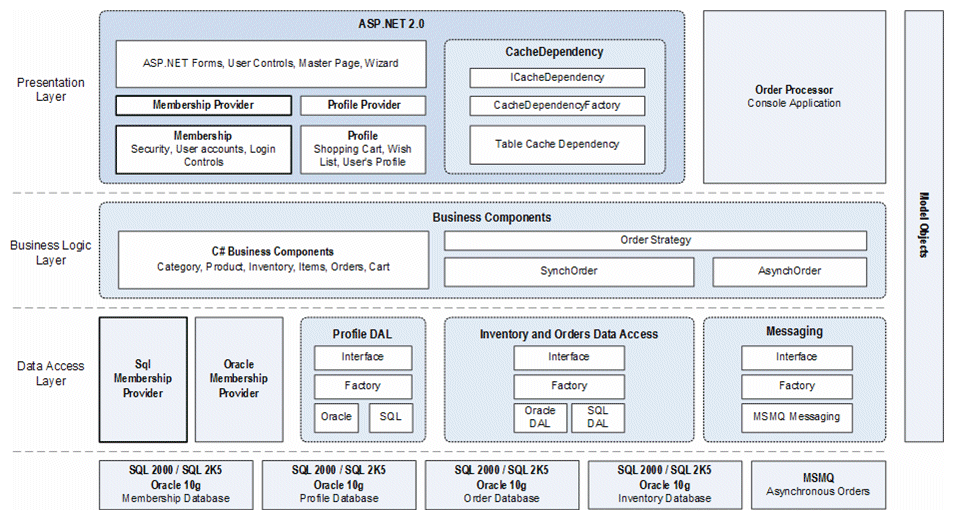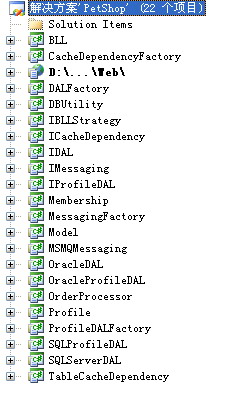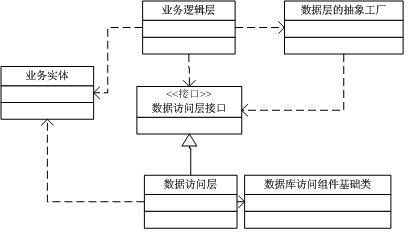日前微软推出了基于.NET Fram work 2.0开发的Petshop 4.新的Petshop4实现了与Petshop 3相同甚至更多的特性,由于采用了Master Pages,Membership,以及Profile,SqlCacheDependency,但是代码量却减少了四分之一.同时,在事务,数据缓存,安全方面使用了.NET 2.0附带的特性,构建了一个灵活的最佳实践的应用程序.
他们利用了Project Conversion Wizard把项目从ASP.NET 1.1移植到了ASP.NET 2.0,然后做了以下改动:
1.用System.Transactions代替了原来的Serviced Components提供的事务功能
代码实现:PetShop.BLL.OrderSynchronous 的 public void Insert(PetShop.Model.OrderInfo order).
2.用强类型的范型集合代替了原来的弱类型集合
public IList GetProductsByCategory(string category)
{
// Return new if the string is empty
if (string.IsNullOrEmpty(category))
return new List();
// Run a search against the data store
return dal.GetProductsByCategory(category);
}
3.采用ASP.NET 2.0 Membership来做认证和授权
4.创建了针对Oracle 10g的Custom ASP.NET 2.0 Membership Provider
5.利用ASP.NET 2.0的Custom Oracle 和 SQL Server Profile Providers 做用户状态管理,包括购物车等
6.采用了Master Pages,取代了原来的用户控件,来实现统一的界面效果
7.使用了ASP.NET 2.0 Wizard控件实现check-out
8.使用了SqlCacheDependency来实现数据库层次的缓存更新(cache invalidation)功能
9.使用了消息队列来实现异时订单处理.
1.整体架构:

数据库:(暂略)
项目列表:从整体可以看出,Pet Shop 4的项目体系已经很庞大,考虑的方面也较3.0更全面复杂。

2.petShop 4.0 的命名空间 以及各个项目模块的说明
|
序号 |
项目名称 |
程序集名称Assembly Name | 默认命名空间Default Namespace |
描述 |
|
1 |
WEB |
表示层 |
||
|
2 |
Model |
PetShop.Model | PetShop.Model |
业务实体 |
|
3 |
BLL |
PetShop.BLL | PetShop.BLL |
业务逻辑层 |
|
4 |
DALFactory |
PetShop.DAL | PetShop.DALFactory |
数据层的抽象工厂 |
|
5 |
IDAL |
PetShop.IDAL | PetShop.IDAL |
数据访问层接口定义 |
|
6 |
SQLServerDAL |
PetShop.SQLServerDAL | PetShop.SQLServerDAL |
SQLServer数据访问层 |
|
7 |
OracleDAL |
PetShop.OracleDAL | PetShop.OracleDAL |
Oracle数据访问层 |
|
8 |
DBUtility |
PetShop.DBUtility | PetShop.DBUtility |
数据库访问组件基础类 |
|
9 |
CacheDependencyFactory |
PetShop.CacheDependencyFactory | PetShop.CacheDependencyFactory |
缓存依赖类的工厂类 |
|
10 |
ICacheDependency |
PetShop.ICacheDependency | PetShop.ICacheDependency |
缓存依赖类接口 |
|
11 |
TableCacheDependency |
PetShop.TableCacheDependency | PetShop.TableCacheDependency |
缓存依赖实现类 |
|
12 |
IBLLStrategy |
PetShop.IBLLStrategy | PetShop.IBLLStrategy |
同步/异步处理策略接口(实现在bll根据配置反射选择) |
|
13 |
MessagingFactory |
PetShop.MessagingFactory | PetShop.MessagingFactory |
异时处理消息队列的抽象工厂 |
|
14 |
IMessaging |
PetShop.IMessaging | PetShop.IMessaging |
异时处理消息队列接口定义 |
|
15 |
MSMQMessaging |
PetShop.MsmqMessaging | PetShop.MsmqMessaging |
异时处理消息队列的实现 |
|
16 |
Profile |
PetShop.Profile | PetShop.Profile |
Profile的数据访问层 |
|
17 |
ProfileDALFactory |
PetShop.ProfileDALFactory | PetShop.ProfileDALFactory |
ProfileDAL的工厂类(反射创建ProfileDAL) |
|
18 |
IProfileDAL |
PetShop.IProfileDAL | PetShop.IProfileDAL |
Profile的数据访问层接口定义 |
|
19 |
OracleProfileDAL |
PetShop.OracleProfileDAL | PetShop.OracleProfileDAL |
Oracle的Profile Providers 做用户状态管理 |
|
20 |
SQLProfileDAL |
PetShop.SQLProfileDAL | PetShop.SQLProfileDAL |
SQL Server 的Profile Providers 做用户状态管理 |
|
21 |
Membership |
PetShop.Membership | PetShop.Membership |
Membership认证和授权管理 |
|
22 |
OrderProcessor |
PetShop.OrderProcessor | PetShop.OrderProcessor |
后台处理进程,处理订单队列 |





 拨丝抽茧的来看,先不去管 Profile 和 Membership 和消息队列以及缓存。
拨丝抽茧的来看,先不去管 Profile 和 Membership 和消息队列以及缓存。3层结构主要的结构如下,最值得注意的地方当然是类工厂的使用了,在我看来,类工厂是最有用的模式之一,因为只有它能让我们摆脱对具体类的依赖而转而依赖抽象,依赖我们只需要的逻辑,而不去管实现的逻辑。

3.Petshop 4中的设计模式:
工厂模式:
首当其冲的就是工厂模式,很容易就可以看出来,也是应用最多的。
DALFactory:数据访问层的抽象工厂(决定创建哪种数据库类型的数据访问层。可以选择:SQLServer,Oracle)
CacheDependencyFactory:缓存依赖类的工厂类。(创建具体表的缓存依赖)
MessagingFactory :异时处理消息队列的抽象工厂(反射创建具体的异时处理类)
ProfileDALFactory:ProfileDAL的工厂类(反射选择创建Oracle 和SQL Server的 ProfileDAL)
策略模式: IorderStrategy

中介模式
CategoryDataProxy ItemDataProxy ProductDataProxy
